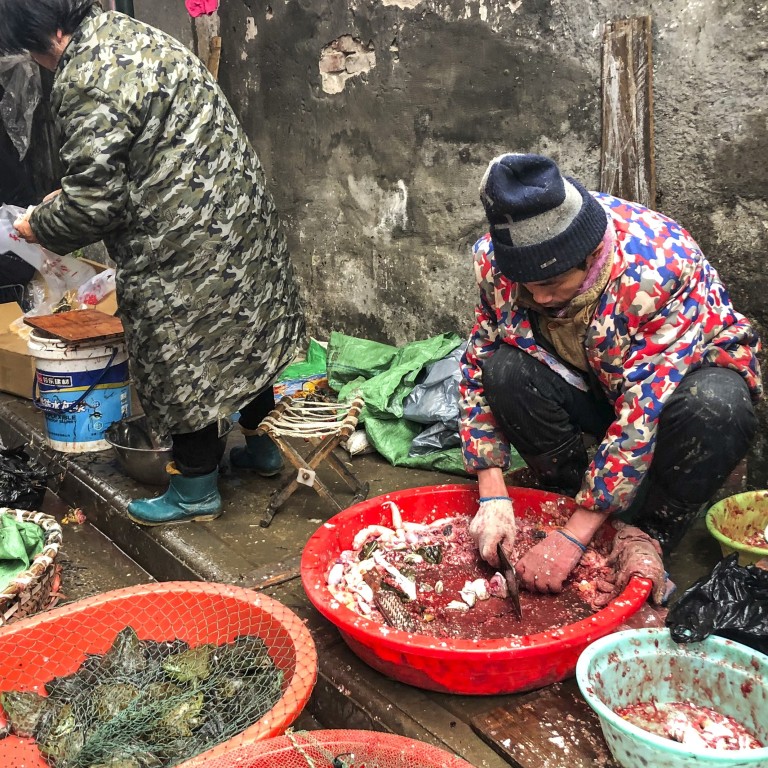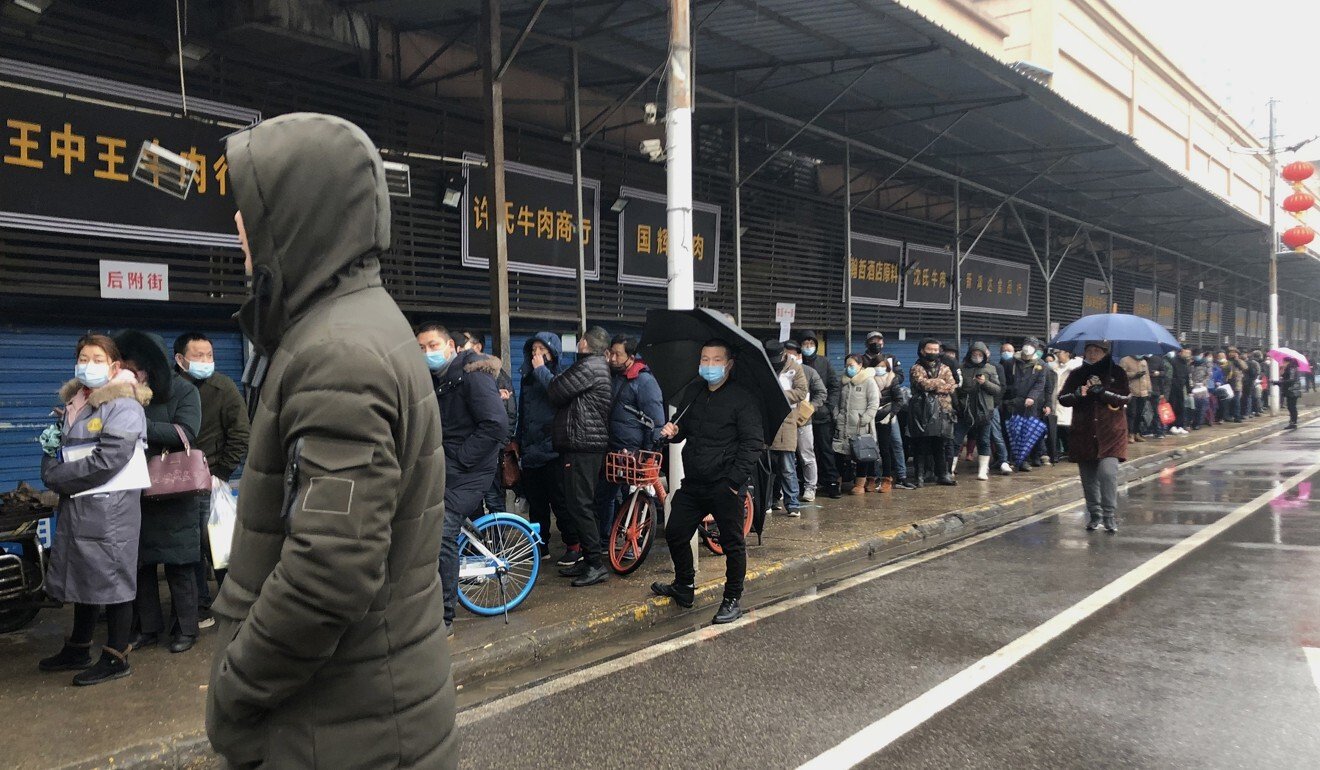
Coronavirus: Thousands of wild animals were sold at Wuhan markets in months before Covid-19 outbreak, new report finds
- Findings by Chinese and British researchers highlight scale of trade in wild species and the poor conditions in which they were kept
- The animals on sale include species known to be susceptible to coronaviruses – such as civet cats, mink and raccoon dogs – but not bats or pangolins
Thousands of wild animals were sold in markets in the Chinese city of Wuhan ahead of the Covid-19 outbreak, new research has found.
The study by British and Chinese researchers shines a spotlight on the active animal trade in the city, which has long been considered a potential source of the outbreak.
In the most detailed record of wild animal sales yet to be published, the scientists estimate that more than 47,000 wild animals were sold in the city’s markets in the two and a half years before the disease emerged.
In monthly site visits to 17 shops selling wild animals across four markets in Wuhan between May 2017 and November 2019, researchers documented the sale of 38 species.

02:46
Chinese rats, cobra farmers face debt and poverty after wildlife ban
These included mammals such as civet cats, mink and raccoon dogs, which are known to be susceptible to coronaviruses, along with squirrels, badgers, foxes and hedgehogs, as well as birds and reptiles.
Seven of the vendors monitored were at the Huanan Seafood Wholesale Market, which was linked to a number of the earliest known cases of Covid-19 in late 2019.
Wildlife believed to be main source of coronavirus outbreak, survey finds
Some 1,100 individual animals were being moved through city markets on average monthly, in a trade that the researchers describe as both ripe for spreading disease and “fundamentally illegal”.
“Almost all animals were sold alive, caged, stacked and in poor condition. Most stores offered butchering services, done on site, with considerable implications for food hygiene and animal welfare,” said the researchers, from China West Normal University and Oxford University, who received their data directly from stall owners as part of a study to monitor tick-borne disease.

One member of the WHO team, veterinarian David Hayman, said the research confirmed that live wild mammals were on sale in Wuhan – something the team had suspected but not been able to verify.
It also provided clear proof that several species that are known to be susceptible to coronaviruses related to severe acute respiratory syndrome (Sars) were “consistently being supplied to the market”, said Hayman, who is co-director of the OIE Collaborating Centre in Veterinary Epidemiology and Public Health at Massey University in New Zealand.
“The data provide more support for investigating if these potential intermediate hosts were infected and provided pathways from regions where evidence suggests more Sars-related coronaviruses persist in nature, such as other parts of China and Southeast Asia, to Wuhan during the winter,” he said.
Covid-19 investigators turn focus onto Chinese wildlife farms
The trade in wild animals was identified as a possible transmission route for the virus, which is thought to have originated in bats.
Many, but not all, of the earliest known cases were linked to the Huanan market, and a later analysis found that over half of the first known cases in December 2019 had exposure to this or other city markets.
But no link has been found between the animals on sale in the market and the virus.
The Chinese authorities said that only frozen wild animals were found at the Huanan market and tested after it was closed on January 1 2020.
The WHO team report, based on information from the Chinese authorities, only said that snakes, crocodiles and salamanders – which are less likely to have been infected with coronaviruses – were being sold live in the market in late December 2019.
“It’s important [to know] that there are mammal species that are alive and being sold in Wuhan markets immediately prior to the recognition of the onset of Covid-19 that are susceptible to Sars-like coronaviruses, either Sars-1 or Sars-CoV-2,” said Daniel Lucey, an infectious disease specialist at Georgetown University Medical Centre in the US.
An end to wolf warriors? China adds 517 species to protected wildlife list
“This is important missing data … and it raises the question in my mind about what more data exists that hasn’t been made public,” he said.
Zhou Zhao-min, one of the co-authors of the paper, said the data could not be shared during the review process. The research was originally submitted in February last year but was rejected by several international journals before the submission to Scientific Reports in October, he said.
“I hope this data could be helpful to trace the origins of Sars-CoV-2 [the coronavirus that causes Covid-19]. For example, mink was on sale in the markets, while Sars-CoV-2 has been reported in mink farms in Europe and North America,” Zhou said, adding that the paper also “highlights the shortages of wildlife management”.

02:25
Pangolins continue to face threat of extinction despite wildlife trade bans
In the paper, the authors directly question an assertion in the WHO report that no illegal wildlife sales were identified in the Huanan market, noting it would be “impossible” to make this determination because of the lack of regulation.
Around 30 per cent of the mammals being sold were clearly caught in the wild according to the data.
Game over for China’s wildlife food trade, but does ban go far enough?
Many of the mammal species on the list were those that had been tested in captivity for the coronaviruses by researchers in Hubei province following the outbreak, according to data in the WHO report.
When asked whether the latest data will be taken into account, a WHO spokesperson said that a technical team was preparing a proposal for the next studies to be carried out based on a review of the mission report.
Yanzhong Huang, a senior fellow for global health at the Council on Foreign Relations in New York, said the latest research underlined that work conducted under the auspices of the WHO mission was “currently not thorough”.
“They have not exhausted their research, which suggests more in-depth work needs to be done in China,” he said.

